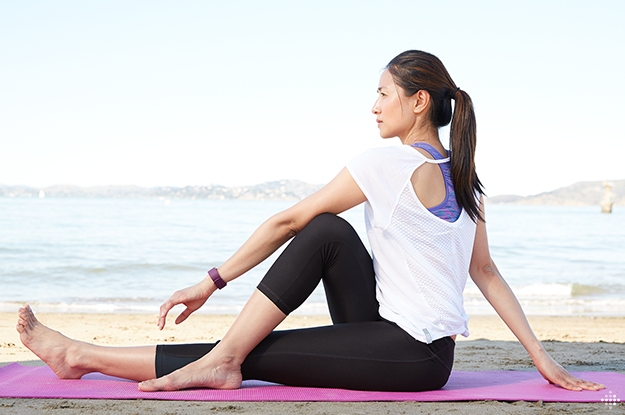Have you ever noticed how high-stress situations at work activate your fight or flight response? To prepare for combat or run from a threat, you take rapid shallow breaths and your body releases the hormone cortisol, telling the liver to stimulate glucose production and send sugar into the blood. That oxygen hit and sugar increase provides an energy boost for immediate physical reaction, but most office stressors don’t require such a response. Presenting in front of your entire department isn’t the same as boxing a bear, after all.
The real problem with those small stressors: they’re not doing anything helpful for your health. “Elevated amounts of cortisol over time can wreak havoc on your system, leading to bigger problems of weight gain, obesity, diabetes and even hypertension,” says Andrew Busch, a fitness trainer and Ph.D. candidate in sports management.
Physical activity is an excellent way to deal with daily stress. But when leaving the office for a quick run isn’t an option, you need the next best calm-down trick: breathing. “A controlled breath practice increases oxygen in the blood and improves cardiovascular function,” says Busch. “It can also lower your heart rate.” An effect yoga practitioners have tapped into for centuries.
“Pranayama or ‘vital air’ is a cleansing, deep breathing technique that promotes focus for physical endurance, rids your body of toxins, and quiets anxiety,” explains yoga expert, Linda Bhreathnach. “It’s easy, natural, and free,” she says, “and the more you do it, the more you will realize the benefits.” Best of all, you can do it in your your office chair. Ready to find your Zen among broken printers and urgent emails? Here are 5 simple breathing exercises to try.
Abdominal Breathing
What it is: Breathing with your diaphragm instead of your chest allows oxygen to go deep into your lungs.
How-to: Place one hand on your belly, and the other hand on your chest. Make sure you are sitting upright with good posture. Breathe in through your nose for four counts, hold for one count, and then slowly release the air through pursed lips for four counts. Your belly should be moving more than your chest when you’re doing it correctly.
How long: 10 breaths per session
Ocean Breath (Ujjayi)
What it is: In Hindi, ujjayi translates to “victorious breath,” and it’s one of the most basic and useful techniques in Yoga, says Bhreathnach. “During your practice, this audible breathing technique helps focus the mind, regulates your body temperature, and brings in fresh oxygen,” she says.
How-to: By making your breath audible, you are able to control it more easily.Focus on your glottis—you can feel your glottis move when you whisper. Keep it lifted in the throat while you breathe, so the passage of air sounds like rushing water. The sound will be more pronounced when you exhale through your mouth. Once you master the technique, keep your mouth closed and inhale and exhale through your nose, equal counts.
How long: 5 minutes
Alternate Nostril (Chandra Bhedana Pranayama)
What it is: This technique helps to balance both sides of the body. “By focusing on a specific nostril for breath, we make sure to breathe evenly, helping the body to fully channel its energy,” says Bhreathnach.
How-to: Place your thumb against your nose, closing the right nostril, and inhale deeply. Close off your left nostril with your pointer finger, and release your thumb to open your right nostril; exhale slowly. Next, inhale with your right nostril while your left nostril is closed with pointer finger; and then close your right nostril with your thumb, while exhaling through left nostril. Repeat.
How long: 5 minutes
Bellows Breath (Bhastrika)
What it is: “Bellows Breath is excellent for calming emotions and releasing pent up stress or anxiety,” says Bhreathnach. “You know the relief a deep sigh can bring? This is that sort of relief—times ten,” she says.
How-to: Breathe in slowly through your nose, engaging your diaphragm—your belly should experience an overall expansion. Exhale quickly through the your nose with full force. While quickly exhaling, continue to focus on using your diaphragm. Each inhale-exhale cycle should be completed in 1 to 2 seconds.
How long: 10 breaths per session
Tensing & Relaxing Breathing
What it is: Contracting your muscles distracts the mind from unwanted stressors. This technique should decrease anxiety through interval relaxation.
How-to: With your eyes closed, tense the muscles throughout your body, starting at the top of your head and finishing at your toes. Take a slow, deep breath through your nose and hold it for four seconds. Exhale through your mouth, and slowly release all of the muscles in your body with your breath.
How long: 10 breaths per session
Not sure if these breathing techniques are working? Check your heart rate! When you compare your rates before and after breathing, you should find your heart has slowed and you feel more calm. (To manually track your heart rate: Place your first two fingers on the inside of your wrist, beneath, count the beats for 10 seconds, and then multiply that number by 6 to get “beats per minute.”)
Have you tried these breathing exercises? What helps you de-stress in the middle of a workday? Share your thoughts in the comments!
Learn more about how Fitbit Wellness can help your company develop a great wellness program, create engaging challenges, and improve employee health.
This information is for educational purposes only and is not intended as a substitute for medical diagnosis or treatment. You should not use this information to diagnose or treat a health problem or condition. Always check with your doctor before changing your diet, altering your sleep habits, taking supplements, or starting a new fitness routine.


Nice article Thank you. Adding the arts of traditional medicine to the treatment of what ails us and to help us remain calm and present in our lives.